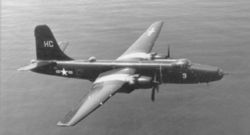PlaneSpottingWorld welcomes all new members! Please gives your ideas at the Terminal.
P4M Mercator
The Martin P4M Mercator was an unsuccessful contender for a United States Navy requirement for a long-range maritime patrol bomber; the preferred aircraft was the Lockheed P2V Neptune. Instead, it saw a limited life as a long-range electronic reconnaissance aircraft. Its most unusual feature was that it was powered by a combination of piston engines and turbojets, the latter being in the rear of the engine nacelles.
Work began on the Model 219 in 1944, with the first flight being on October 20, 1946. A large and complicated aircraft, it was powered by two Pratt & Whitney R4360 Wasp Major 28-cylinder radial engines. To give a boost during takeoff and combat, two J-33 turbojets (De Havilland Goblin clones) were fitted in the rear of the two enlarged engine nacelles, the intakes being beneath and behind the radial engines. The jets, like those on most other piston/jet hybrids, burned gasoline, not jet fuel.
A tricycle undercarriage was fitted, following Navy preferences, with the nosewheel retracting forwards and the single-wheel main legs into coverless fairings in the wings, so that the sides of the wheels could be seen even when retracted. The wings themselves, unusually, had a different airfoil cross-section on the inner wings than the outer.
Heavy defensive armament was fitted, with two 20 mm cannon in an Emerson nose turret and a Martin tail turret, and two 0.5 in (12.7 mm) machine-guns in a Martin dorsal turret. The bomb-bay was, like British practice, long and shallow rather than the short and deep bay popular in American bombers. This gave greater flexibility in payload, including long torpedoes, bombs, mines, depth charges or extended-range fuel tanks.
The US Navy chose the smaller, simpler and cheaper P2V Neptune for the maritime patrol requirement, but nineteen aircraft were ordered in 1947 for high-speed minelaying purposes; these were modified for the electronic reconnaissance (or SIGINT, for signals intelligence) mission in 1951, to replace the PB4Y Privateer. The crew was increased to 14 and later 16 to operate all the surveillance gear, and the aircraft was fitted with a large number of different antennas.
Missions were flown from the Philippines (and, later, Japan) by Fleet Air Reconnaissance Squadron One (VQ-1) along the Chinese borders and along the eastern Russian coasts, and were of a highly secret nature; the aircraft masqueraded as regular P2V Neptunes in radio communications. One Mercator was shot down by Chinese fighters in 1956, while another was attacked by two fighters in 1959 but escaped with injury to one crewman. The aircraft were also operated out of Morocco by VQ-2, where one aircraft was intercepted near Ukrainian airspace by Soviet MiG's. It escaped by flying under jet power but ran out of fuel and crashed into Medeterrian with the loss of all crew.
Replacement was by the EA-3 Skywarrior, which being carrier-based had a greater degree of flexibility. Final withdrawal from service was in 1960. None survived.
Operators
Specifications (P4M Mercator)
Template:Aircraft specification
Related content
Comparable aircraft
Avro Shackleton - PB4Y Privateer - P2V Neptune - P-3 Orion
Designation sequence
Related lists
List of military aircraft of the United States
Lists relating to aviation | |
|---|---|
| General | Timeline of aviation · Aircraft · Aircraft manufacturers · Aircraft engines · Aircraft engine manufacturers · Airports · Airlines |
| Military | Air forces · Aircraft weapons · Missiles · Unmanned aerial vehicles (UAVs) · Experimental aircraft |
| Notable incidents and accidents | Military aviation · Airliners · General aviation · Famous aviation-related deaths |
| Records | Flight airspeed record · Flight distance record · Flight altitude record · Flight endurance record · Most produced aircraft |

